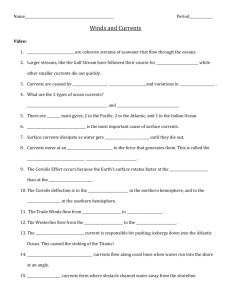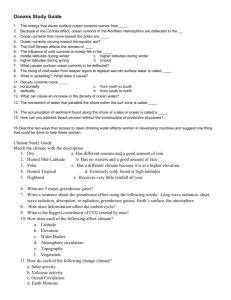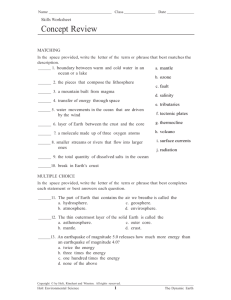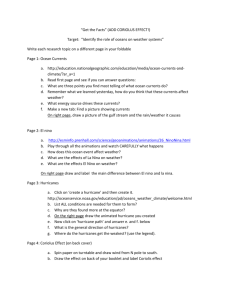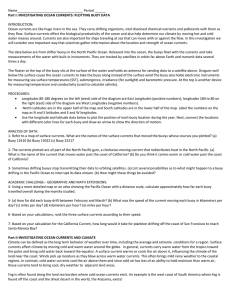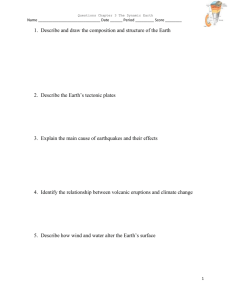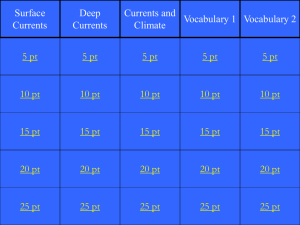Student Instructions
advertisement
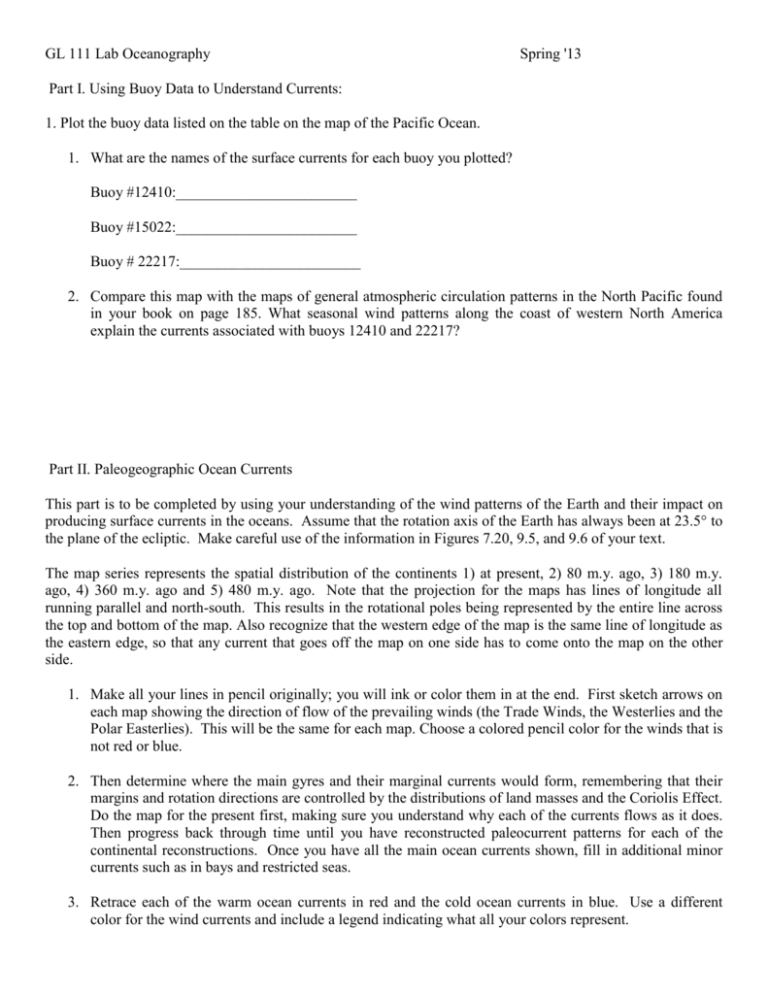
GL 111 Lab Oceanography Spring '13 Part I. Using Buoy Data to Understand Currents: 1. Plot the buoy data listed on the table on the map of the Pacific Ocean. 1. What are the names of the surface currents for each buoy you plotted? Buoy #12410:________________________ Buoy #15022:________________________ Buoy # 22217:________________________ 2. Compare this map with the maps of general atmospheric circulation patterns in the North Pacific found in your book on page 185. What seasonal wind patterns along the coast of western North America explain the currents associated with buoys 12410 and 22217? Part II. Paleogeographic Ocean Currents This part is to be completed by using your understanding of the wind patterns of the Earth and their impact on producing surface currents in the oceans. Assume that the rotation axis of the Earth has always been at 23.5° to the plane of the ecliptic. Make careful use of the information in Figures 7.20, 9.5, and 9.6 of your text. The map series represents the spatial distribution of the continents 1) at present, 2) 80 m.y. ago, 3) 180 m.y. ago, 4) 360 m.y. ago and 5) 480 m.y. ago. Note that the projection for the maps has lines of longitude all running parallel and north-south. This results in the rotational poles being represented by the entire line across the top and bottom of the map. Also recognize that the western edge of the map is the same line of longitude as the eastern edge, so that any current that goes off the map on one side has to come onto the map on the other side. 1. Make all your lines in pencil originally; you will ink or color them in at the end. First sketch arrows on each map showing the direction of flow of the prevailing winds (the Trade Winds, the Westerlies and the Polar Easterlies). This will be the same for each map. Choose a colored pencil color for the winds that is not red or blue. 2. Then determine where the main gyres and their marginal currents would form, remembering that their margins and rotation directions are controlled by the distributions of land masses and the Coriolis Effect. Do the map for the present first, making sure you understand why each of the currents flows as it does. Then progress back through time until you have reconstructed paleocurrent patterns for each of the continental reconstructions. Once you have all the main ocean currents shown, fill in additional minor currents such as in bays and restricted seas. 3. Retrace each of the warm ocean currents in red and the cold ocean currents in blue. Use a different color for the wind currents and include a legend indicating what all your colors represent. 4. Remember that excess heating in equatorial and tropical regions is kept in balance by air and ocean currents transporting the excess heat to the higher latitudes where heating is deficient. Now evaluate the map patterns with their surface ocean currents shown, and decide if any oceanic regions would predictably have inefficient heat-removal such that they would become excessively hot. Shade these regions pale pink to indicate warmer temperatures. Similarly, if you decide any regions would be extra cold because currents are not bringing them heat, shade them very lightly in blue. TABLE 1. NORTH PACIFIC BUOY DATA 12410 12410 12410 12410 12410 12410 12410 12410 12410 12410 Position day 27 Feb 95 28 Mar 95 22 Apr 95 22 May 95 24 June 95 24 July 95 26 Aug 95 25 Sept 95 20 Nov 95 18 Dec 95 15022 15022 15022 15022 15022 15022 15022 15022 15022 15022 15022 22217 22217 22217 22217 22217 22217 22217 22217 22217 22217 22217 Buoy no Latitude Longitude 30.1 27.5 25 23.6 22.5 23.1 20.5 20 17.9 21.4 -123.7 -121.8 -124.6 -128 -133.9 -138.4 -145.4 -147.6 -155.3 -159.5 25 Feb 95 27 Mar 95 23 Apr 95 20 May 95 25 June 95 22 July 95 27 Aug 95 23 Sept 95 23 Oct 95 25 Nov 95 31 Dec 95 10.7 10.5 11.6 12.4 17 21.7 33 37 39.3 40.1 37.6 162 152.1 145.5 137.6 131.1 127.8 141.6 147.8 152 154.5 160.4 27 Feb 95 27 Mar 95 24 Apr 95 29 May 95 26 June 95 24 July 95 28 Aug 95 25 Sept 95 23 Oct 95 27 Nov 95 18 Dec 95 51.2 50.4 48.7 50.7 50.4 51.5 51 53.1 55.2 57.1 56.9 -162.7 -165.3 -159.5 -155.1 -151.7 -149.3 -145 -143.8 -139.1 -141.4 -141.7

